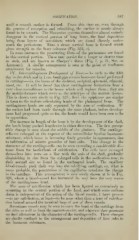Page 577 - My FlipBook
P. 577
OSSIFICA Tioy. 587
until a smooth .surface is formed. From this time on, even through
the process of resorption and rebuilding, the surface is nearly always
found to be smooth. Tlie Haversian systems themselves almost entirely
disappear in the cortical portion of long bones, the tinal deposition
being from layers of osteoblasts which are found directly under-
neath the periosteum. Thus a dense cortical bone is formed which
gives strength to the bony columns (Fig. 324, a).
In some instances the penetrating fibres of the periosteum are found
in this cortical portion. These may persist for a longer or shorter time
as such, and are known as Sharpey's fibres (Fig. 7, p. 41, Sec. on
Anatomy). A similar arrangement is seen at the point of tendinous
attachment for muscles.
IV. Intercartilaginous Development of Bone.—As early as the fifth
day in the chick and in 1 cm. foetal pigs certain bones are found preformed
in cartilage—viz. tlie bones of the skeleton, occipital, sphenoid, ethmoid,
nasal, etc. It will be found that these cartilaginous formations bear a
very close resemblance to the bones which will replace tiiem ; they are
the matrix-formers which serve as the antetypes of the mature tissues.
This is shown very nicely in Fig. 325 ; here the epiphyses are similar
in form to the mature articulating heads of the phalangeal bone. The
cartilaginous heads are only separated by the zone of ossification. If
tlie section had been made through the same phalanx, before develop-
ment had progressed quite so flir, the heads would have been seen to be
in apposition.
The increase in length of the bone is by the development of the shaft:,
the heads being pushed lengthwise in either direction. The first percep-
tible change is seen about the middle of the })halanx. The cartilage-
cells are enlarged at the expense of the intercellular hyaline basement-
substance, which latter is becoming finely granular in appearance, due
to infiltration of minute granules of lime salts. This change in the
character of the cartilage-cells can be seen extending a considerable dis-
tance from the borderland of calcification. The cells have arranged
themselves into rows on a line with the axis of the shaft, gradually
diminishing in size from the enlarged cells in the ossification zone, to
their normal size as found in the unchanged heads. The capillary
blood-vessels push their way into the calcifying cartilage, or, what is
more probable, the penetration of the capillaries antedates the change
in the cartilage. This arrangement is very nicely shown at bv in Fig.
326, where a blood-vessel has burrowed its way into the very centre
of the cartilaginous head.
The zone of calcification which has been figured so extensively as
occurring in the central portion of the head, and which some authors
claim is independent of the action of the blood-vessels, I have proven
—to my satisfaction, at least—to be none other than a zone of calcifica-
tion located around the terminal loop of one of these vessels.
Sometimes vessels may be seen to enter the head of the cartilage from
the sides as well as from the marrow-cavity, and wherever they penetrate
we find alterations in the character of the cartilage-cells. These changes
are chiefly confined to the arrangement and deposition of lime salts in
the basement substance.


